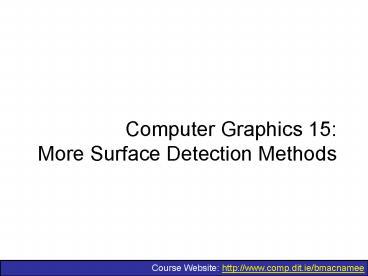Computer Graphics 15: More Surface Detection Methods - PowerPoint PPT Presentation
1 / 11
Title:
Computer Graphics 15: More Surface Detection Methods
Description:
... rectangles for the two surfaces do no ... also be used. 9. of. 11. Ray-Casting. 10. of ... to make sure that we only draw visible surfaces when rendering ... – PowerPoint PPT presentation
Number of Views:336
Avg rating:3.0/5.0
Title: Computer Graphics 15: More Surface Detection Methods
1
Computer Graphics 15More Surface Detection
Methods
2
Contents
- Today we will continue to look at visible surface
detection methods - Depth-sorting method
- Other methods
- We will also compare the different techniques we
have studied and suggest when different
techniques should be employed
3
Depth-Sorting Method
- A visible surface detection method that uses both
image-space and object-space operations - Basically, the following two operations are
performed - Surfaces are sorted in order of decreasing depth
- Surfaces are scan-converted in order, starting
with the surface of greatest depth - The depth-sorting method is often also known as
the painters method
4
Depth-Sorting Method (cont)
- First, assume that we are viewing along the z
direction - All surfaces in the scene are ordered according
to the smallest z value on each surface - The surface S at the end of the list is then
compared against all other surfaces to see if
there are any depth overlaps - If no overlaps occur then the surface is scan
converted as before and the process repeats with
the next surface
5
Depth Overlapping
z
zmax
S
zmax
S
zmin
zmin
x
No Depth Overlap
Depth Overlap
6
Depth-Sorting Method (cont)
- When there is depth overlap, we make the
following tests - The bounding rectangles for the two surfaces do
no overlap - Surface S is completely behind the overlapping
surface relative to the viewing position - The overlapping surface is completely in front of
S realtive to the viewing position - The boundary edge projections of the two surfaces
onto the view plane do not overlap
7
Depth-Sorting Method (cont)
- The tests are performed in the order listed and
as soon as one is true we move on to the next
surface - If all tests fail then we swap the orders of the
surfaces
8
Other Techniques
- There are a number of other techniques all based
around are division - BSP-Tree Method
- Area-Subdivision Method
- Octree Methods
- Raycastig can also be used
9
Ray-Casting
10
Comparison Of Visibility-Detection Methods
- When few surfaces are present either the depth
sorting algorithm or the BSP tree method tend to
perform best - Scan-line also performs well in these situations
up to a several thousand polygon surfaces - The depth buffer method tends to scale linearly,
so that for low numbers of polygons its
performance is poor, but it is used for higher
numbers of polygons.
11
Summary
- We need to make sure that we only draw visible
surfaces when rendering scenes












![Real-Time Volume Graphics [04] GPU-Based Ray-Casting PowerPoint PPT Presentation](https://s3.amazonaws.com/images.powershow.com/5690756.th0.jpg?_=20201119122)


















